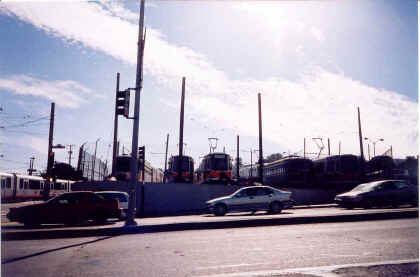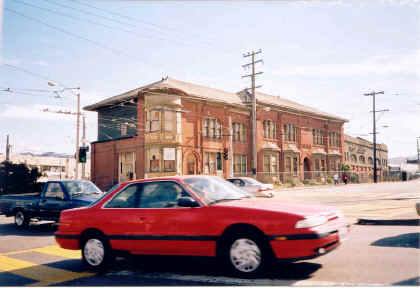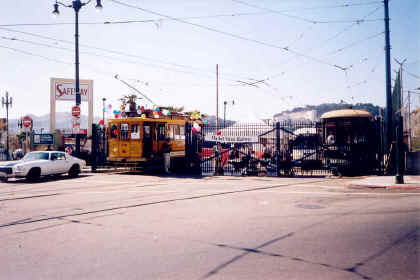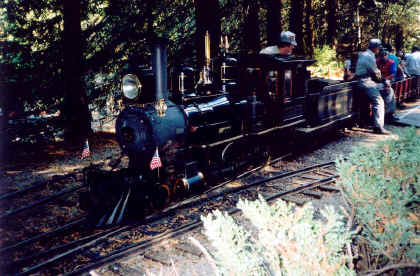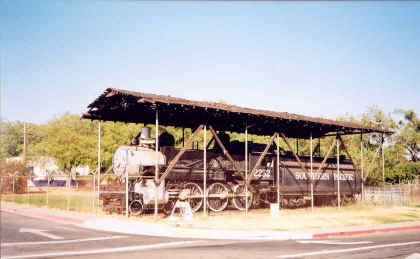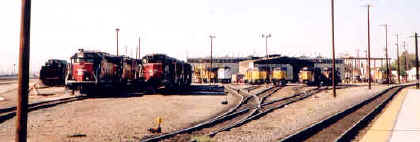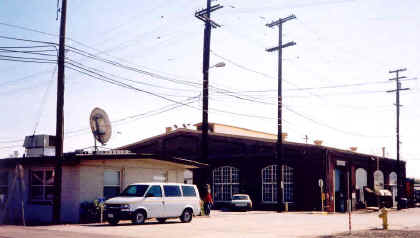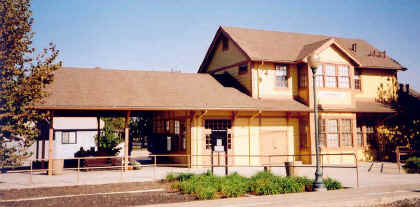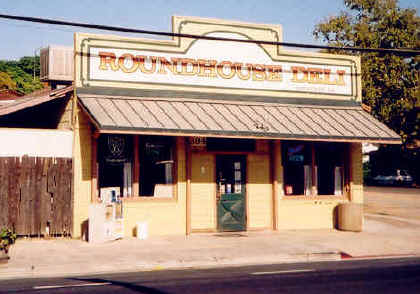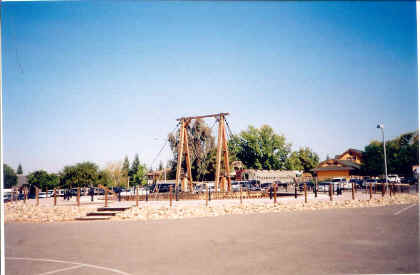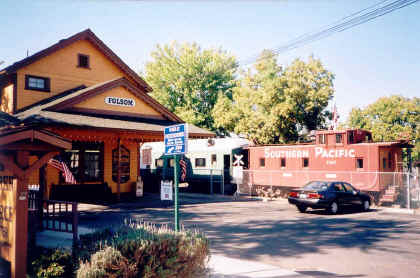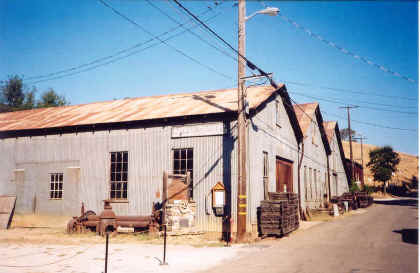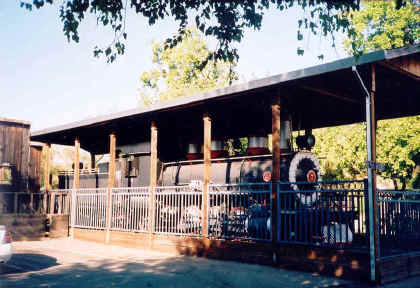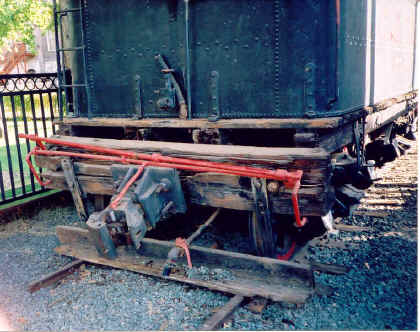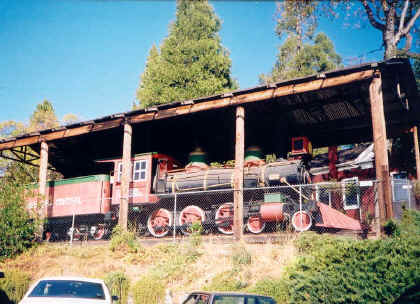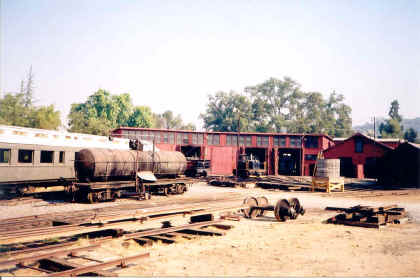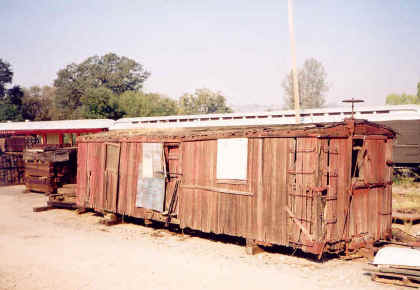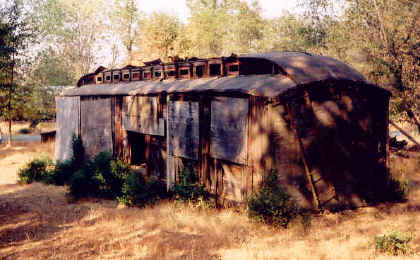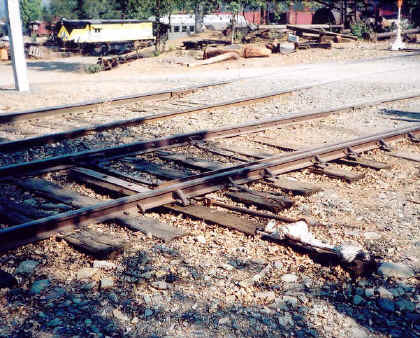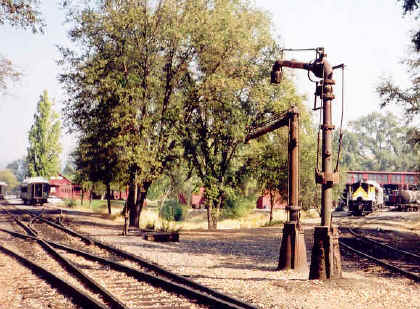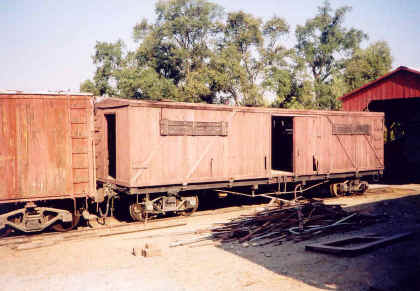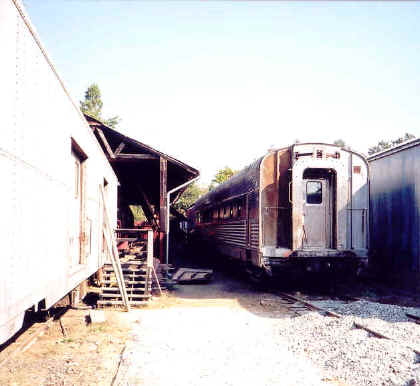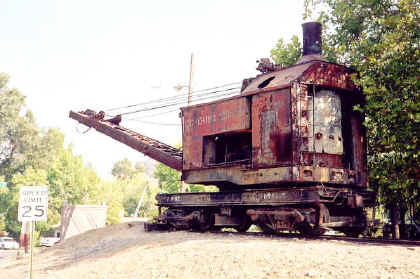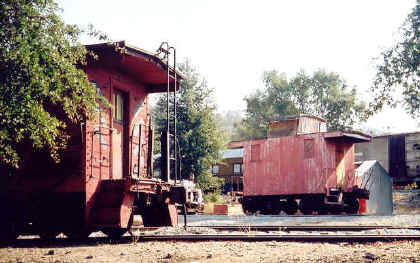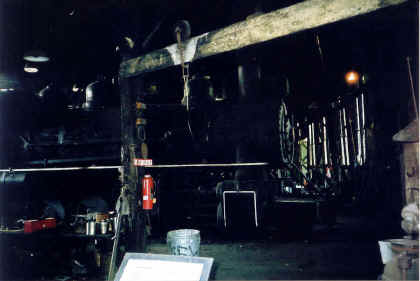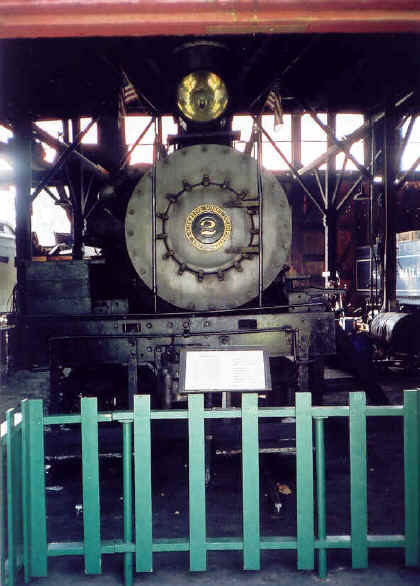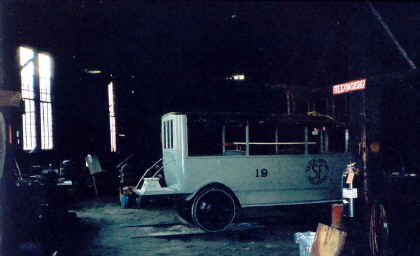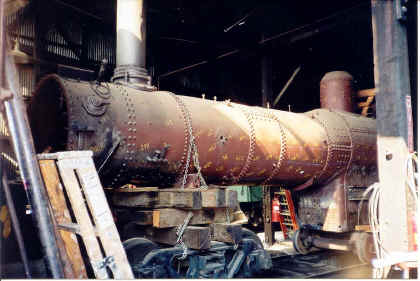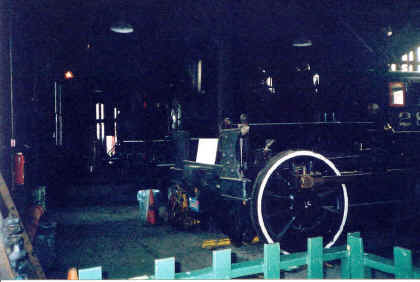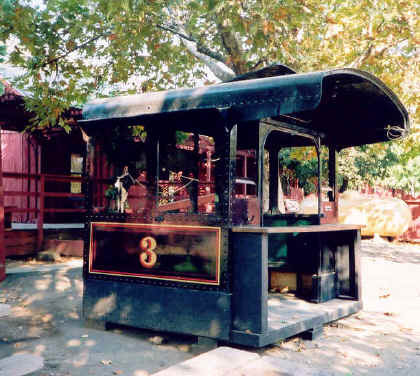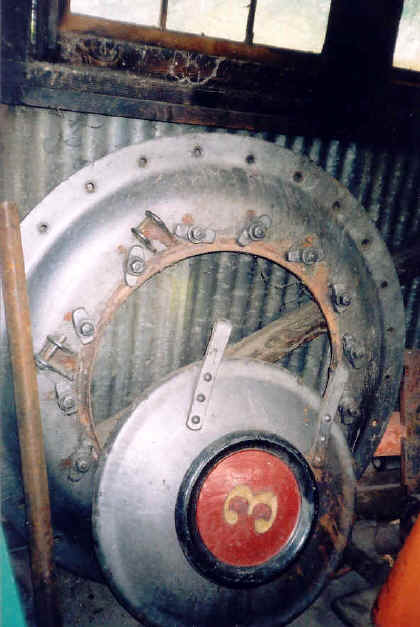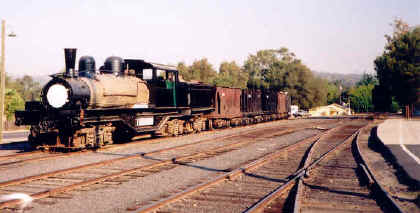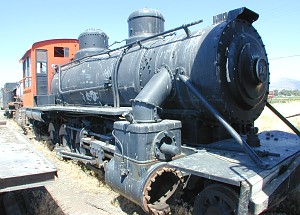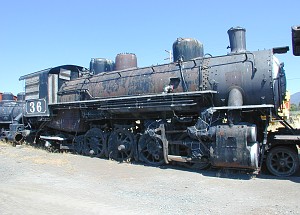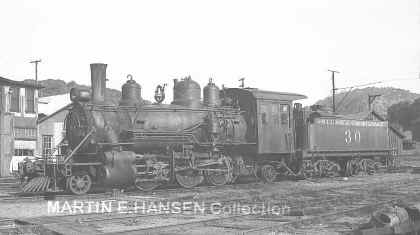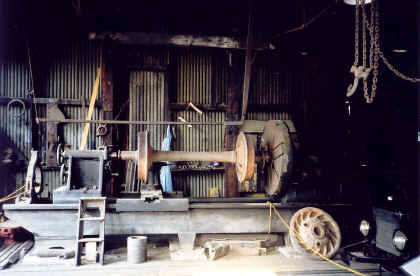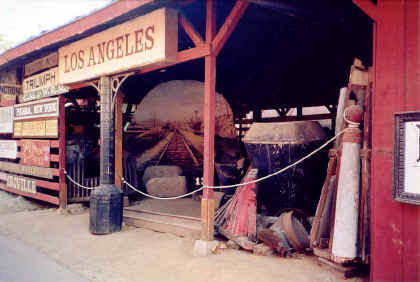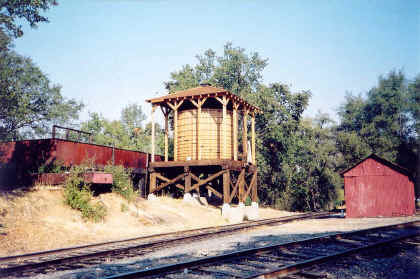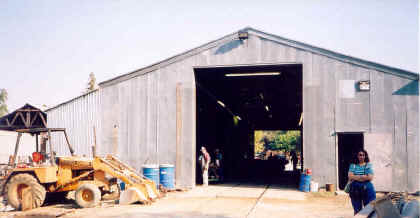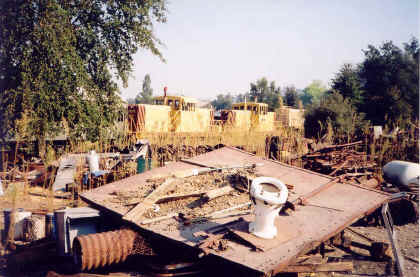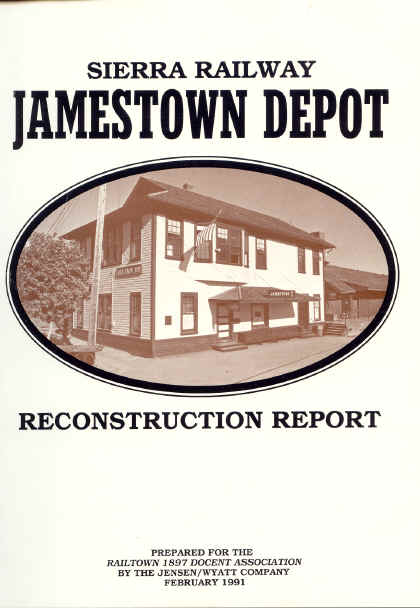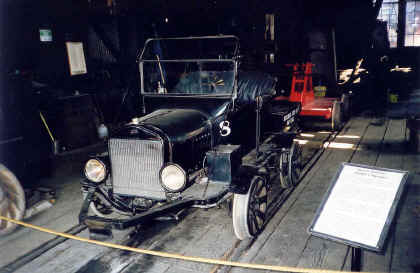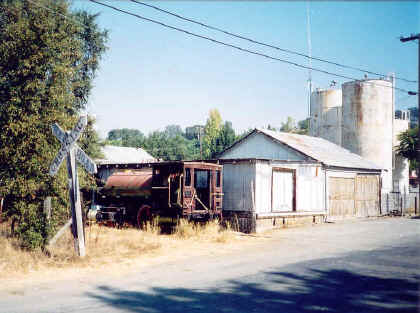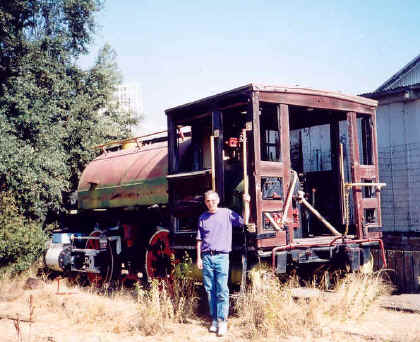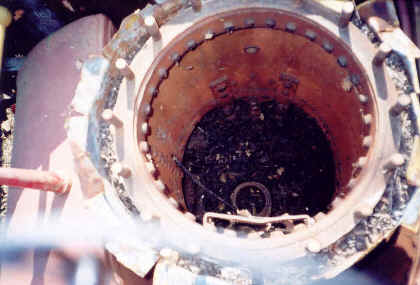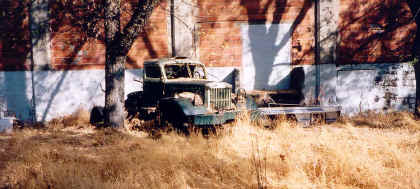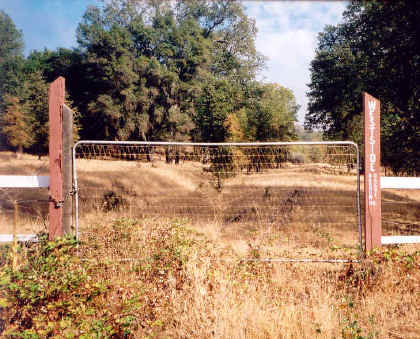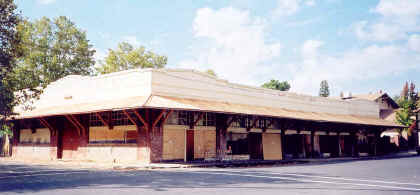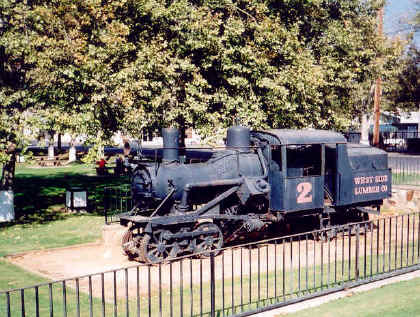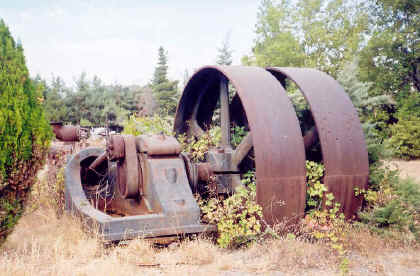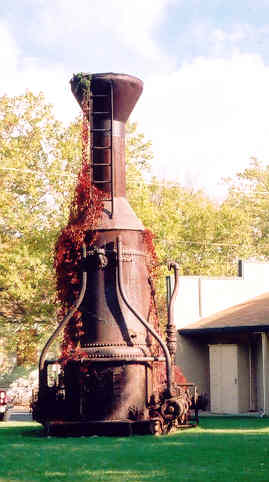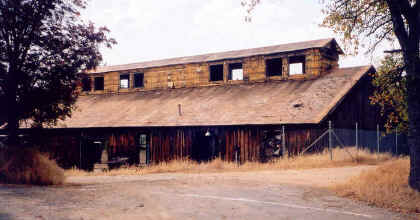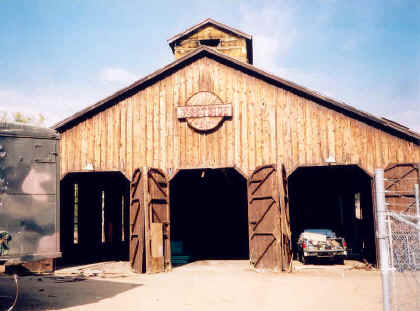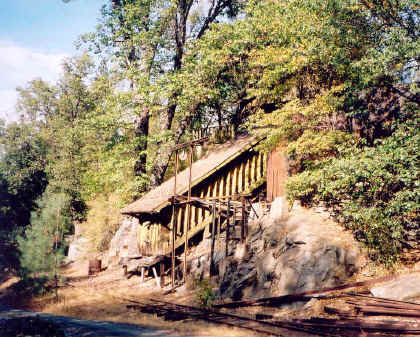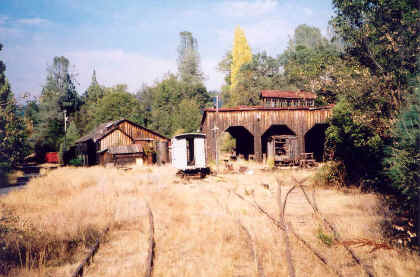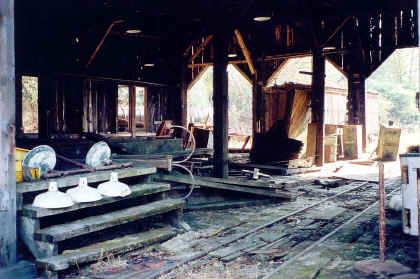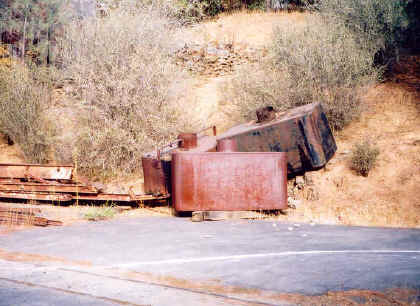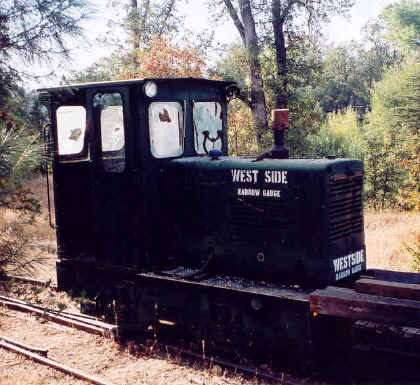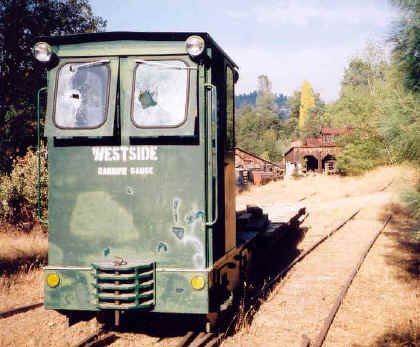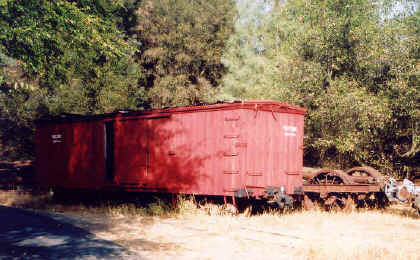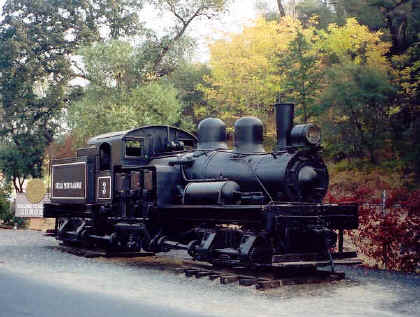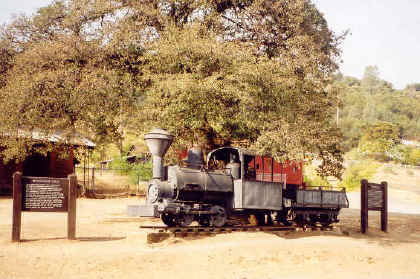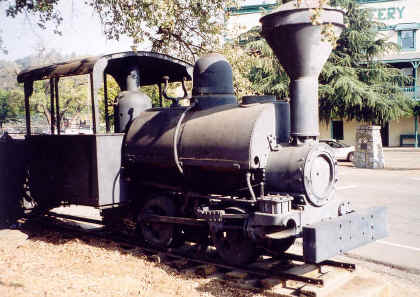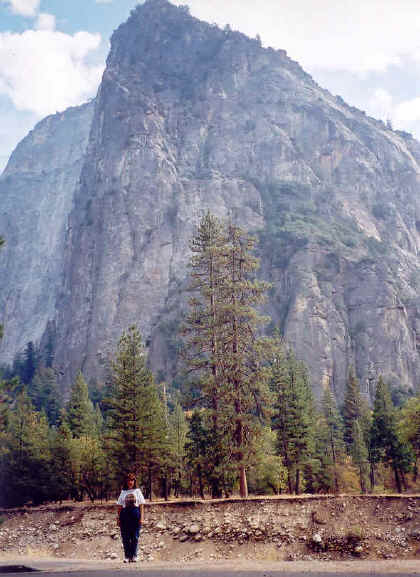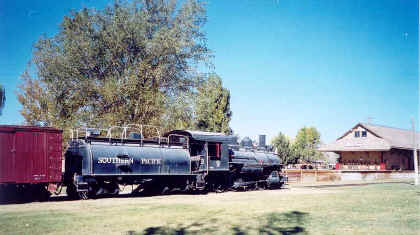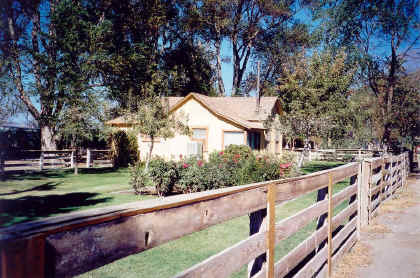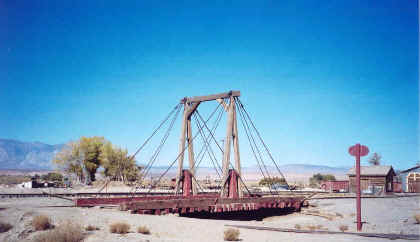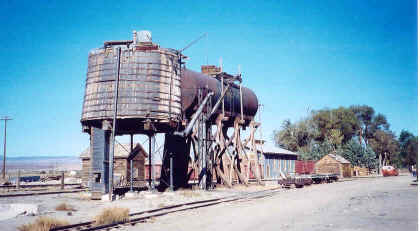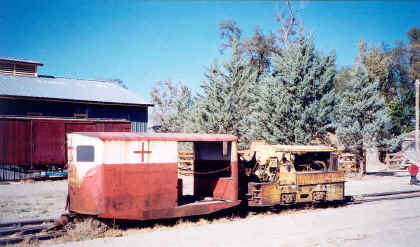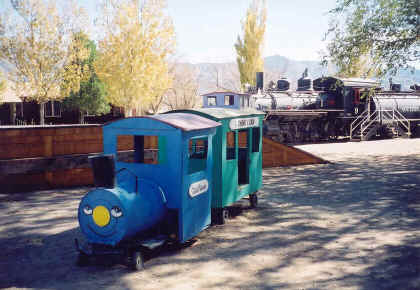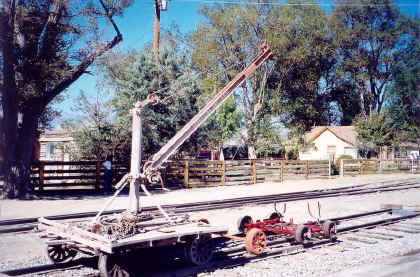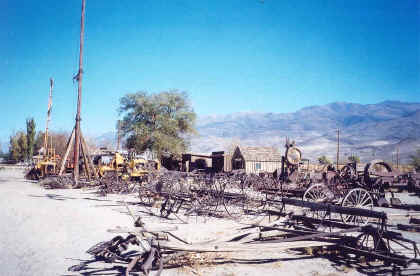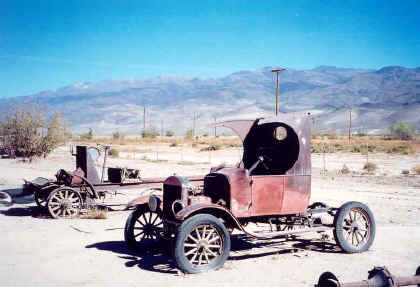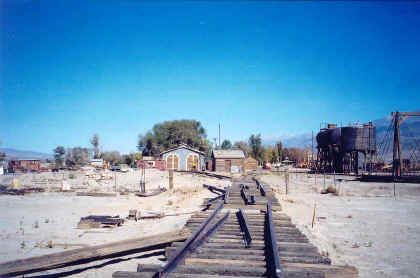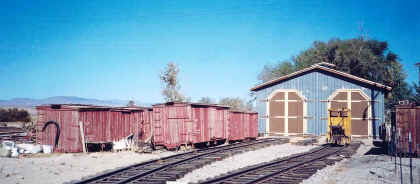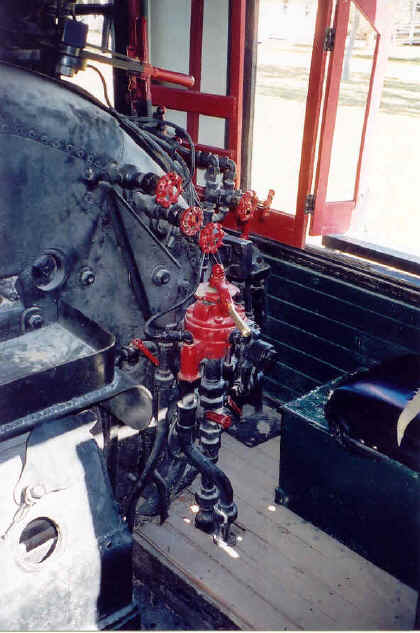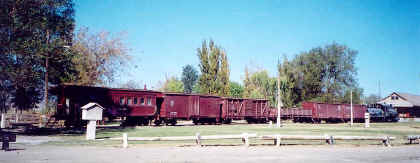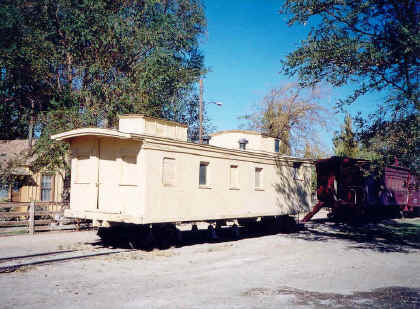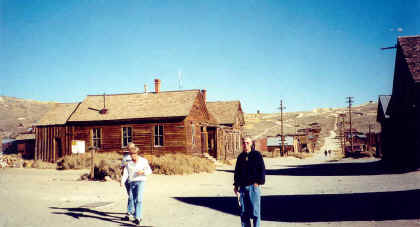After some bad Greek fast food the first night and a dismal bowl of soup the next, we're pretty discouraged with eating in downtown Sacramento. On the morning of departure, however, we find an old-fashioned hamburger joint in a tiny building near our motel, which serves a great bacon and eggs breakfast. Clippings on the wall show it's famous locally, started by two laid-off shop men from the Western Pacific, who gave up the railroad to become cooks. The light rail line runs right outside the door.
I-80 west is crowded and does nothing to calm my wife's dread of busy traffic. Along the way, we run over an extension ladder that fell off a truck, and this doesn't help. No damage done though, and we continue to Richmond, where we meet our daughter at the BART station. A true city person, she drives us the remaining torturous (for my wife) miles across the Bay Bridge and into San Francisco. It takes over an hour to find a place to park, constantly circling a several block area. The day isn't over yet, so I walk two blocks to the J Church light rail line and ride it to the end. The Muni system shops are located here, in a modern facility. There's a storage yard behind, which includes some old PCCs awaiting restoration, and across the street from that is a brick building built in 1887 for the San Francisco & San Mateo Railway. The Market Street Railway folks hope to make this part of a Muni museum eventually, once seismic upgrades are completed.
I've promised reader Randy Hees to come over to Newark and see what the Society for the Preservation of Carter Resources has accomplished at Ardenwood Historic Farm Regional Park. They are restoring and replicating a collection of old narrow gauge cars rescued from dereliction all over the west, mostly built by the Carter Brothers car shops, whose factory was once located nearby. Their usual motive power is a horse (though they roster some tiny gas/diesel "critters"), and the line replicates a short branch of the South Pacific Coast Railroad that was never upgraded for steam operation.
Fear of losing that precious parking space wins out, however, so Saturday finds me at the Duboce Street restoration yard of the Market Street Railway group, just a block from my daughter's apartment. The Market Street volunteers (who were/are heavily involved in the reinstatement and operation of the F Market trolley line and currently pursuing an extension from Fishermans Wharf to Fort Mason) are having a small open house event today. For my small fee I get a nice calendar and a ride on a New Orleans trolley as far as Mission Park on the J Church line. The open "boat tram" from Blackpool, England is operating also. In the afternoon it's down to the waterfront to watch the Navy's Blue Angels aerobatic team via the F Market trolley and Van Ness bus line. The busses seem to carry more smelly, deranged people than the trolleys and we're glad to get off. The Angels put on a good show and don't crash into each other. Leaving, we walk briefly around the Maritime Museum and see the smelly seals at Pier 39. Going home, public transport is full (the F Market trolleys are almost constantly full anyway) and it's a long walk back along the Embarcadero to Market Street. I note the old State Belt Railroad roundhouse, under commercial renovation last year, still doesn't have tenants. Too bad it couldn't have become a museum for the few pieces of remaining State Belt equipment.
On Sunday we head over to Berkeley for a brief tour of the city, ending at Tilden Park. Here is the famous
Redwood Valley Railway, created in the 1950s by Erich Thomsen, a German immigrant who later worked for the SP and WP. The 15-inch gauge line has a 1 1/4-mile mainline connected by loops at each end. The right-of-way winds through a redwood forest that the group planted some 30 years ago. Originally built to 12-inch gauge, the first motive power was an Ottaway 4-4-0 restyled to look like a narrow gauge engine. The gauge was converted in the late-1960s, after Thomsen built his first 15-inch locomotive, an accurately scaled 5/12-size narrow gauge 4-4-0. Several more locomotives followed, including a 4-6-0, 2-4-2 and others. Visiting engines appear at special events also. It's a nice ride, but the city should build
proper restrooms after all the effort they have put forth; Port-O-Lets, even clean ones, just aren't a good introduction to a harried family, most of whom have to visit the bathroom as soon as they arrive. The
Golden Gate Live Steamers have a smaller mixed-gauge operation nearby and are running, but we don't ride. North of Rancho Cordova is Roseville, where an ancient SP "fire engine" 4-6-0 is displayed. Roseville is also the home of UP's main locomotive shop in the west, and we seek out both. Appearing as a sleepy dot on the map, the small city has now become a Sacramento suburb and we pass a sea of shopping centers before arriving at the compact downtown. We miss a turn from our Mapquest directions and have to ask our way to the fairgrounds, but finally find old No. 2252 off in a corner, behind a fence. Headlight and injectors are missing, but she is relatively intact, though in need of care. The roof of the protective shelter needs repairs to shut out the daylight streaming through.
It was called a "fire engine" because it once sported a large pumping apparatus atop the boiler and pulled a train of tank cars, for firefighting use in the Donner Pass snowsheds. Nos. 2248 and 2252 were so equipped, and maintained to near the end of SP steam. No. 2248 was backdated to look like an older engine and became the SP's ceremonial locomotive in the 1950s. The latter now operates on the Grapevine Steam Railroad (formerly Tarantula) in Texas. No. 2252 was donated to Roseville in 1956 and has sat ever since. The Tarantula folks have made some effort to acquire it in recent years, but I hope it ends up as a display in the Sacramento erecting shop.
Roseville once had a big roundhouse, servicing mostly the huge cab-forward engines for the Donner Pass route. Today, there is just one old brick building left, attached to the newer metal diesel house. The turntable is still in place. Rotary snowplows are kept here, and there is a motley collection of tired and dirty ex-SP power. Dick Steinheimer took some impressive shots of the then-new "black widow" SP diesels being worked on here in the 1950s. The Roseville Amtrak Station looks old, but is actually a new structure, built to standard SP plans and painted in authentic colors, a nice touch compared to the typical drab Amtrak facility. Across from the diesel shop, the Roundhouse Deli serves rail workers, taking the place of the old railroad beanery.
Next stop is Folsom, where the Folsom, Eldorado & Sacramento Historical Railroad Association has reconstructed a replica of a Central Pacific wooden gallows turntable. Nearby is the original depot, with a few pieces of passenger, freight and maintenance-of-way equipment under restoration behind a fence. Their website indicates they hope to eventually operate trains on a remaining unused portion of the SP Placerville Branch, which, as the Sacramento Valley Railroad, was the first railroad built in California. The depot office is open, but the elderly lady running the information desk must be having a bad day. No one else is around to ask what is going on. The turntable itself looks authentic enough, but a fancy brick sidewalk and railings surround it, looking more suited to a shopping mall fountain than a railroad yard. The former rail yard has been bulldozed into a parking lot, with the turntable isolated high and dry in the middle. Nearby is Folsom's Sutter Street, with a collection of old gold rush buildings housing antique, craft, and other shops. There's a museum at nearby Folsom Prison as well, but time is too limited this trip. Onward to Placerville, turning south on Route 49, toward the Mother Lode gold country.
Sutter Creek is the first stop. I'm not sure if they ever had a railroad here, but Sutter Creek is home to the Historic Knight Foundry, an 1870s iron foundry that once produced numerous products for the mining and railroad industries. The foundry was commercially active until the 1980s, when declining revenues forced it to close. These days, it's only open occasionally for tours, but a chapter of the Society for Industrial Archeology has formed to preserve and eventually revive the site. Toward the end, Knight Foundry produced some castings used in the restoration of Virginia & Truckee locomotives, as well as others. A veritable "East Broad Top" of a historic industrial site, it is fully intact and capable of going back into business when preservationists can find the funds and political help to do so. Housed in corrugated metal buildings, the foundry is at the end of a tight dead-end street, with several residences nearby. Considering the NIMBY factor, I'd be surprised if the neighbors didn't complain if operations were to start up again.
A slight detour brings us to Ione, California, which reminds me of tiny Ione, Colorado, north of Denver, and the hackneyed joke always heard when passing by in the car: "There's the town I own". In the park behind the police station sits Iron Ivan, a Baldwin 2-6-2, last used by the Amador Central RR. This locomotive was built for the McCloud River RR as No. 8, being sold to the AC about 1939. Twin sister No. 9, also ex-McCloud River, ran until recently in Wisconsin. Beebe & Clegg pictured this locomotive in their Mixed Train Daily book in more workaday dress; the plain footboard pilot has since been exchanged for a boiler-tube type and the big firehose reel has been removed from the pilot deck. The engine went into standby service after the AC purchased a GE diesel in the late 1940s, and was put on display about 1956.
Iron Ivan, actually ACRR No. 7, is under a shelter, but has clearly seen better days. The engine appears mostly intact, but all the wood is rotten and asbestos lagging is still on the boiler. The wild red and aluminum paint job it wears has done little to slow deterioration. The Amador Central itself is still in business, with a metal enginehouse in nearby Martell, but now called the Amador Foothills RR. It currently rosters two rare Baldwin diesel switchers, one of which is used as a parts source. Operations are said to be occasional, when the owning wood products firm needs a move.
Back on Route 49, we make a stop at Jackson to see yet another locomotive. Locomotive is actually a misnomer, because this one is almost entirely built of wood. It is a 1:1 scale replica of Rio Grande Southern 4-6-0 No. 20, the real version of which has long reposed at the Colorado Railroad Museum. In 1949, the real No. 20 appeared in a western film called
Ticket to Tomahawk, starring Dan Dailey and Anne Baxter, with a tiny bit part by Marilyn Monroe. In the movie, old No. 20 was supposedly dragged across the mountains by animal power to start a new railroad. For those scenes, the movie studio built the wooden replica, with movable wheels and considerable detail. The replica eventually had several owners before winding up on display near the historical museum in Jackson. It's under cover and surprisingly well preserved. To ease rolling it around, the wheels have no flanges. Beebe & Clegg spoke of doing some heavy gambling in Jackson before heading over to Martell and Ione to see the Amador Central. Railtown 1897, now a California State Park under the control of the California State Railroad Museum, is to me, America's premier historic railroad site. Unlike most other rail museums that were newly built, this is a real place, that has seen few changes over the years. Very little of its history has been compromised or contrived. Unlike, say Steamtown at Scranton, the folks who worked here in the 1920s, '30s and '40s would still recognize it. Though the place has been made safe for visitors, there has been no excessive prettying-up of the grounds.
The structures here are original and un-compromised. Even the modern metal building that houses most of their newer machine tools is authentic, having been installed during major dam construction in the 1950s. Sometimes called the East Broad Top of the West, there is an important difference between the two; the Jamestown site is publicly-owned and has been assured of preservation; the EBT is neither so far, despite vigorous effort on the part of its supporters. The buildings at Jamestown even have fire protection systems. Through Paul Hammond, I've had contact with Jim Stillwell, the California Park Service administrator for the site. Jim is in full uniform, pleasant, and makes up name badges that allow us full access to Railtown 1897. My spouse buys a book on the life of old west prostitutes and reads it on a bench with "Railtown Kitty", the local feline, while I wander the grounds.
There are no trains running today, but I'm not really here for action photography; it's the integrity and completeness of the historic site I marvel at. There is little here that doesn't belong. A couple of modern SP "economy" baggage cars and a diner from the California Zephyr don't quite fit in, but they are safe here until more appropriate homes are found. There are some surplus military diesels and a steel caboose or two that could probably be parked elsewhere, but they might get vandalized if they were. The rest of the rolling stock is mostly from the area, with pieces from the nearby Pickering Lumber Company's railroad as well as the Sierra. Inside the roundhouse (a wood-framed building with corrugated metal siding), Sierra 2-8-0 No. 28 sits silent, though it would be making its last trip before overhaul within a week or so. Mikado No. 34, a privately owned engine that thankfully never left, sits beside it. According to the sign, it last ran in 1980. Feather River Railway Shay No. 2 is also there, presently the site's only operable steamer. Somewhat of an interloper historically, the Shay became property of the State of California in the 1960s, when dam construction ended operations on the railway, based at Feather Falls, California.
Queen of the fleet is, of course, old No. 3, the 4-6-0 seen by millions around the world in movies and TV programs. It's presently heavily dismantled, with boiler on shop trucks and the running gear in an adjacent stall. Some wags have hung a California license plate on the back of the frame; the cab sits on display near the freight house, which today houses Railtown's offices and gift shop. No. 3's boiler has chalk lines mapping ultrasonic testing; it will be a while longer before the 1891 Rogers struts again; CSRM Foundation members are doing fundraising for this purpose.
One of the much-modeled short "Angels Camp" passenger cars is also kept in the roundhouse, in splendid condition. The only steam left outside is former Pickering Lumber Co. Shay No. 7, an un-restored display attached to some ancient ore cars near the freight house; this engine is said to be privately owned. Pickering Lumber's extensive Sugar Pine Railway operation connected with the Sierra at nearby Ralph, California. There was a brief, unsuccessful attempt to turn the outer end of that line into a tourist railroad in the late-1960s and No. 7 made a couple of runs about 1970. The rails were lifted and the route is now a trail. Nearly all of the Pickering geared locomotive roster survived, however, scattered around the West. At least a couple have operated in recent years.
There are also five more ex-Sierra steam locomotives extant, all but two owned by the same person that owns No. 34. No. 18, a 2-8-0 that appeared in numerous movies in the 1930s and '40s, and 2-8-2 No. 36 both currently sit derelict in a field near Merrill, Oregon. No. 18 was retired in the early 1950s, with its tender sold to another shortline for further use behind another engine. Somehow, the remaining hulk escaped scrap, being placed on display at a trailer park for a time and moved to other California locations before final trucking to Oregon. No. 36 worked a tourist railroad in Arizona for a while, then ended up at Heber and Ogden, Utah before moving north. On its way up from Arizona, the gooseneck trailer hauling it reportedly came apart, with the locomotive digging nose first into the pavement.
Sierra's biggest engine was No. 38, a large 2-6-6-2 logging Mallet acquired from Weyerhauser in Oregon in 1952. The road's chief mechanical officer was reportedly more familiar with steam locomotives than diesel and got a good deal, thus staving off dieselization three more years until his death. In 1955, No. 38 moved north to Washington's Olympic Peninsula to work for Rayonier, operating well into the late-1960s. Sierra then went diesel, acquiring two Baldwin S12 switch engines, retaining steam only for movie work and excursions. No. 38 became available as an HO scale brass model and thousands were produced, becoming well known as "the Sierra". Placed on display by Rayonier in a rain forest climate after retirement, the real locomotive came close to scrapping when the company abandoned its Railroad Camp site. Saved by the current owner, it has lain dismantled at McCloud, California for many years. Sierra No. 30, a 2-6-2, was sold to the Howard Terminal Railway in the 1930s, becoming a saddletank engine on that tiny East Bay switching road. It was acquired by the Pacific Locomotive Association in the 1960s and is currently under repair at their Niles Canyon Railway. It will be given a tender from another departed locomotive and regain its former Sierra appearance. PLA also owns former Sierra three-truck Shay No. 12, built by Lima in 1903. In its early years, Sierra had a small fleet of Shays and Heislers, with all sold to lumber companies early on. No. 12 was sold to Standard Lumber in 1924, and ended its days with Pickering. Currently stored with PLA's other logging engines in a huge metal building at Niles, California, No. 12 has operated in recent years, notably at Vancouver's Steam Expo in 1986. One might hope that these five engines find their way back to Jamestown eventually, even if just for reassembly as static displays.
Attached to the roundhouse is the Sierra's machine shop, originally the enginehouse before the roundhouse was built in 1910. The shop has all its original machinery, complete with belt drive system. The machines are still capable of being used, though most work today is done on newer equipment housed in the metal Tri-Dam building. The older machines are demonstrated on special occasion. There is a wooden car shop, a storehouse and lumber shed, carpenter shop, blacksmith shop and two small shops for motorcar and gasoline vehicle repair. The lumber shed contains many props from the movies, including fake station signs and smokestacks for No. 3. A large, flat bunker C oil tank remains in place beside a wooden water tank on the main line. The Tri-Dam building, though of modern metal construction, is also authentic, having been added in the 1950s during major dam construction on the Stanislaus River. Like any rail yard or museum, there are some piles of junk around the periphery, some historically appropriate, some not.
The main missing building at Jamestown is the passenger depot, a two-story frame structure destroyed by fire in 1978. Many of the Sierra Railroad's historic records were lost in the fire as well. Plans and fundraising have been underway for its replication for some years, but have not reached fruition yet. Today, the only surviving Sierra depots are at Angels Camp and Standard, both used as residences.
On this Tuesday morning, there are few visitors. Like tourism everywhere since 9/11, visitation has been down at Railtown, but CSRM Foundation volunteers and the Park Service have been making good effort at promotion. Special trains operate often and special movie events actually re-create scenes from famous movies filmed on the property, with look-alike actors. It's a long and complicated story, but there are actually two separate entities involving the Sierra. One is the Sierra Railroad, still a freight-hauling common carrier, which operates between Oakdale and Standard, where Sierra Pacific Industries operates a major wood products plant. Sierra Railroad sold the Railtown site to the state in 1982, after developing and operating it as a tourist attraction itself for a time (the somewhat corny Railtown 1897 name was adopted at that time, suggested by a commercial ad agency). Sierra Railroad also operates the Golden Sunset Dinner Train out of its Oakdale terminal, a dinner train comprised mostly of rebuilt commuter cars. The railroad and state seem to have an amicable relationship. The Railtown equipment is lettered Sierra Railway today, utilizing the road's pre-1937 name. More details on Sierra RR history and the development of Railtown 1897 can be found in good articles in the Jan/Feb 1989 and March/April 1994 issues of Locomotive & Railway Preservation magazine. Initially, the Park Service, already burdened with more sites than the state's finances could afford, wanted nothing to do with the Railtown complex; only after a long and difficult struggle by supporters was it acquired. Tour complete, we leave Railtown, but I'm already making mental plans to return. There's little doubt this is where I'd like to be after retirement. Just down the road is what may or may not be a personal link with my own family history. Nearly hidden behind some old wooden buildings belonging to an oil dealer is an ancient and very derelict 0-4-0T. This engine was the subject of my Dad's Engine article on this website some time ago. Built by and for the Chicago, Rock Island & Pacific sometime in the 1880s, the little teakettle migrated west around the turn of the century to work industrial switching jobs for at least couple of owners. Out of use by WWII, it miraculously escaped the scrap drives, moving from the Los Angeles area to National City, near San Diego. A museum there traded it to the private contractor that was then operating Railtown for two wooden coaches, and it migrated again, to Jamestown. When that company left Jamestown for the LA area, the sad little bucket of rust came near scrapping. At that time, four associates at CSRM raised funds to buy it for salvage price and began dismantling it for repairs. After removing (and safely storing) a great many parts, the relationship soured between some of the members and work was halted. No beauty queen, the engine's future restoration will likely be on the back burner until someone with a passion takes up the cause. It will be a major project, even if only cosmetic repairs are attempted. Operation probably isn't possible without a whole new boiler, and the holey smokebox will need heavy patching even if it doesn't get one.
Notes on the website of The Train Source (formerly Short Line Enterprises), the engine's last owner, indicate its last Rock Island number may have been No. 11. If so, it was the switch engine at Fairbury, Nebraska around the turn of the century, about 200 miles east of Goodland, Kansas, where I grew up. This was determined from an old photo in the book Rock Island Town, by South Platte Press. At that time, my great grandfather ran sister No. 13 in the yard at Goodland, and an old photo of him and the crew became the main spark for my lifelong interest in railroads. Standing next to the little saddletanker, my fading memories flood back to the four-year-old boy sitting beside the old crippled man on the couch, being regaled of the latter's proud but brief days as a railroad engineer. It's often said you can't go home again, but right now I'm feeling pretty close.
Nearly everything that could be unbolted off the engine has been removed, but I'm assured the pieces are safely stored. The boiler has had its steam dome cover taken off, but I'm not suited up for a boiler inspection today, and my removal might provide amusement for the rescue squad - or fodder for one of Fox TV's dumb events programs. With luck, I'd like to return and make a difference in the future of this little locomotive; time will tell.
After a nice lunch in Jamestown (which also has some nicely-restored old hotels on its short "wild west" main drag), we head for Tuolumne, to see if anything remains of the West Side Lumber Company's narrow gauge railroad and sawmill. The West Side Lumber Co. was one of the Sierra RR's main reasons for existence, and Tuolumne was the end of the line. The last several miles of the Tuolumne Branch are now said to be owned by the Tuolumne Recreation District and out of service due to a mile of track that was removed in the 1980s. The missing mile, removed during condominium construction, has been the subject of lawsuits ever since. For a time, a volunteer group maintained the disconnected section of track and operated motorcars over it, but this apparently has stopped. Local landowners are reportedly pushing to have the rails removed. We cross over the track several times on the way to Tuolumne.
A volunteer at Railtown has told me that only the sawdust burner remains at the old Westside site, but I'm curious anyway. Tuolumne is a small town that looks not to have recovered from the loss of its major industry. The only remains readily visible of the WSL Co. are the burner, the main WSL office building, boarded up and deteriorating, and Heisler No. 2, incomplete and displayed in the local park. Though I don't see much else, I've heard there is more, and drive around a bit. Behind the office building is the mill's big stationary engine, rusting in the weeds, but there is little other evidence of the huge sawmill that burned in the early 1960s. Some volunteer firemen tell me that a distant building in the field was the enginehouse of the later West Side & Cherry Valley tourist operation, but it is being torn down. There was another obviously rail-related building on the way into town, and we crossed over some narrow gauge tracks near it, so I squeeze past the gate and warning signs and enter the property, now owned by the local Indian tribe. It's a long, dusty walk, but I see what looks like the remains of a big loop of track, installed by owner Glen Bell (Taco Bell founder) when he turned the mill site into a tourist railroad. Coming closer, it is obvious that the building is being stripped, but it is unclear if for re-roofing or demolition. A number of odd military surplus vehicles are stored nearby. I take a few photos and walk the long trail back to the gate by the firehouse, where a huge steam donkey engine is displayed. Later, I learn the enginehouse has been leased to the Tuolumne County road department for storage.
Leaving town, we cross over the narrow gauge tracks again and I catch a glimpse of some narrow gauge rolling stock behind another gate that the track passes through. I stop the car and assure my wife I'll be right back, slipping past the fence. A short distance brings me to what I was looking for - the original enginehouse and shops of the WSL narrow gauge railroad. Later consultation with a site map shows that these buildings were used for car repair in later years, but the three-stall building was the original enginehouse of the Hetch Hetchy & Yosemite Valley (a WSL predecessor) before a newer enginehouse was built some distance to the south. The buildings are all heavily weathered, with the track in place, but mostly full of non-rail junk today. Nearby are water and oil tanks, a few pieces of rolling stock and a small gas or diesel four-wheel locomotive with its windows broken out. These are the remnants of the last attempt at operating trains at the site, as seen on this website. According to the website, negotiations continue with the Me-Wuk tribe towards saving the historic buildings and keeping the remains of the railroad on-site. It turns out that I was within a short distance of these old buildings when I made the long walk from the other gate to see the WS&CV enginehouse, a hazard of exploring without a knowledgeable guide.
Returning to the car, my shoes are full of sandburs (having lived in the East for over 30 years, I'd forgotten about them) and my wife has panicked, fearing me injured or dead. It takes a while before I can explain what I've found, and what it means to me to have seen it.
Though much of the rolling stock and all of the locomotives of Westside have survived elsewhere, it looks doubtful if they'll ever come back here again. Too bad, as the Sierra, Pickering Lumber and West Side Lumber were all interdependent at one time, and this would have been a good area to interpret California logging history, with live steam trains as part of the plan. As we leave the next morning, we double back briefly to Sonora, where Pickering Shay No. 3 is on display near the fairgrounds. The engine is in reasonable condition, and not missing too many parts. Then it's on down Highway 49 toward Yosemite National Park. The road begins climbing, twisting and turning, to my wife's chagrin. Evidence of forest fires lines the road. At Coulterville, there is a small local museum, which displays "Whistling Billy" a tiny Porter 0-4-0T built in 1904. This two-foot gauge locomotive ran for the nearby Merced Gold Mining Company, which ceased operation about 1920. Numerous important pieces are missing and part of the right cylinder has been broken away. It's clearly been a while since Billy has whistled.
Thus far, the plan has been to continue south to Mariposa, then east toward the park, stopping at El Portal to see ex-Hetch Hetchy Railroad (later Pickering Lumber) Shay No. 6 and visit the narrow gauge Yosemite Mountain-Sugar Pine Railroad at Fish Camp, which operates former Westside Shays. The museum curator at Coulterville tells us, however, that the road has even more twists and turns than the one we've just come over, so my wife strongly suggests we take the J20 road east out of Coulterville, which leads directly to Yosemite. In exchange, she gladly agrees to let me head south to Bishop after visiting the park and crossing the Sierras.
The Valley Tour at Yosemite is everything it is cracked up to be, and not terribly crowded at this time of year. We view nature's wonders, eat a stale sandwich from the Yosemite Village store, and depart, missing the historic Awhanee Lodge. Hopefully, this will not be our last trip here. The trip over the mountains and Tioga Pass is long and slow, but the scenery and vistas are great, especially further to the east. The night is spent at Lee Vining, California, near the eastern gateway to the park.
The next morning it is south to Bishop, the main commercial center in the Owens Valley and home to the nearby Laws Railroad Museum and Historical Site. This museum is the last main vestige of the Southern Pacific's Carson & Colorado narrow gauge line, abandoned in 1960. The historic site contains the original depot and agent's house, plus the much-modeled wooden gallows turntable, water tank and pumphouse. SP No. 9, a 4-6-0, and several freight cars are displayed on trackage left in place after the abandonment.
After the line ceased operations, a number of other old buildings were brought to the site to create a historical village. These contain representative displays of what pioneer life was like, and collections of various antiques. Some of the buildings are movie sets from the 1960s western Nevada Smith, filmed here. Various pieces of mining and farm equipment are on display outside. In recent years, the Owens Valley Railroad Committee, a volunteer group, has been working to make a live railroad operation here. Piles of donated rail abound and some new trackage has been laid. The initial plan was to build westward into Bishop (where the railroad never ran), but this has changed to utilize the original roadbed south toward Keeler instead. The group has constructed a new metal enginehouse, which has angle-top swinging wooden doors and a cupola for a more authentic appearance.
In the enginehouse, former Death Valley Railroad railcar No. 5 is under repair with ISTEA funding, for eventual operation. Unfortunately, I fail to make contact with the person in charge of the project and a more detailed visit will have to wait for a return trip. Eventually, of course, they'd like to steam up old No. 9, which appears amazingly complete; it looks like the dry climate has preserved it pretty well for an open display. The trailing freight cars, some built in the 1880s, are well painted.
Having seen only photos of this famous site for 50 years, I'm glad to be here. When the railroad ceased operations in 1960, there was not much left except the railroad structures, but long before that, Laws was an actual town, with numerous buildings. The recreated village attempts to replicate that, and no doubt makes it more interesting for the average tourist to visit. An operating railroad should help attract visitors.
Though the narrow gauge track ran only between Laws and Keeler after 1943, it previously extended north to Mina, Nevada. My Slim Rails Through the Sand book has maps indicating that several businesses just north of the depot used rail service, but they are either gone or heavily modernized today, with no evidence of the railroad visible.
The Bodie Railway, built in the early 1880s, was an isolated line that ran south from Bodie over 30 miles to timbered areas south and east of Mono Lake, to supply timbers and cordwood for the mines and mill at Bodie. It was abandoned and scrapped in 1918, after mining decreased and electric motors supplanted steam boilers at the mill. I later learn the Friends of the
Bodie Railway & Lumber Company have found and restored one of the old flatcars, now displayed at June Lake. After ceasing to haul timber and minerals, the track was used briefly to haul tourists in an old automobile converted into a railbus. ~ to be continued ~ |
